6.2 Initiating Movement
Before initiating movement on a main track, a crew member must:
- Receive a track warrant.
- or
- Determine from the train dispatcher or yardmaster if any track bulletins are needed.
6.3 Main Track Authorization
Do not occupy main tracks unless authorized by one of the following:
- Rule 6.13 (Yard Limits)
- Rule 6.14 (Restricted Limits)
- Rule 6.15 (Block Register Territory)
- Rule 9.14 (Movement with the Current of Traffic)
- Rule 9.15 (Track Permits)
- Rule 10.1 (Authority to Enter CTC Limits)
- Rule 14.1 (Authority to Enter TWC Limits)
- Rule 14.6 (Movement Against the Current of Traffic)
- Rule 15.3 (Authorizing Movement Against the Current of Traffic)
- Rule 16.1 (Authority to Enter DTC Limits)
- At manual interlockings, verbal authority from the control operator or a controlled signal that indicates proceed
- Special instructions or general order
If movement stops while the trailing end of the train is between the outer opposing absolute signals of a control point or manual interlocking, the movement must not change direction without permission from the control operator.
At an automatic interlocking, the train movement may change direction within the limits of the interlocking if it continuously occupies at least one car length of the limits.
When cars are shoved on a main track or controlled siding in the direction authorized, movement must not exceed:
Determine the location of the following train by radio or other means of communication.
A train standing on the main track to meet an opposing train must, if possible, line the switch for the opposing train to leave the main track. However, within ABS, do not line the switch until the opposing train has entered the block in advance.
If the engineer fails to comply with the restriction, the conductor must stop the train.
All movements entering or moving within yard limits must be made at restricted speed unless operating under a block signal indication that is more favorable than Approach.
Against the Current of Traffic
Movements against the current of traffic must not be made unless authorized or protected by track warrant, track bulletin, yardmaster, or other authorized employee.
In CTC Territory
Where yard limits are in effect in CTC territory, the control operator must authorize any movement on the main track. Reverse movements within the same block may be made as outlined in Rule 6.4.1 (Permission for Reverse Movements).
Protected by Stop Signs
If stop signs protect these areas, the train must stop before any part of the train or engine passes the stop sign. The train cannot proceed until the route is clear or drawbridge position permits movement.
If a gate is lined against the intended route, trains and engines must stop and remain at least 50 feet from fouling the track on the conflicting route until the gate is changed to the stop position on the conflicting route.
Where required, restore gate to its normal position after movement is complete.
Obscured View of Conflicting Route
If a train must stop before entering a railroad crossing at grade and the view on the conflicting route is obscured, a crew member must go ahead of the train and signal from the crossing when it is safe to proceed.
Flag protection is not required against following trains on the same track if:
When a train is moving on a main track at or more than half the maximum authorized timetable speed for any train at that location, and the train may be overtaken by a following train, a flagman must decide whether to drop lighted fusees by considering the following:
When a train is moving on a main track at less than half the maximum authorized timetable speed for any train at that location, a flagman must provide flag protection against following trains on the same track. The flagman must drop off single lighted fusees at close enough intervals to ensure full protection and not exceed the burning time of the fusee.
When a train stops on a main track, and flag protection must be provided against following trains, a flagman must immediately go back at least the distance prescribed by the special instructions or other instructions for that territory. When reaching the correct distance, the flagman must place torpedoes on the rails, leave one lighted fusee, and may then return half the distance to the train and must remain there until he stops a following train or is recalled.
When the train departs, a crew member must leave one lighted fusee. In addition, until the train is moving at least half the maximum authorized timetable speed for any train at that location, a crew member must drop off single lighted fusees at intervals shorter than the burning time of the fusee.
E. Opposing Movements
When required, a flagman must protect the front of the train from opposing movements by immediately going ahead of the train at least the distance prescribed by the special instructions for that territory. When reaching the correct distance, the flagman must place torpedoes, light a fusee, and remain at that location until recalled.
F. Before Reaching Prescribed Distance
If the flagman hears or sees a train approaching before reaching the prescribed distance, the flagman must immediately place torpedoes, continue toward the approaching train, and give stop signals.
G. Responsibility for Protection
A flagman must not permit other duties to interfere with the protection of the train. The conductor and engineer are responsible for ensuring that any needed flag protection is provided for their train.
When a train requires protection, the engineer must signal a flagman immediately to provide protection. Crew members who cannot hear these signals are still responsible for protecting the train.
If the switch is located within a block other than the one occupied, do not make movements under this protection until 5 minutes after the switch has been lined. Also, make sure no train or engine is between the switch and the train or engine being protected or is within or closely approaching the block where the switch is located.
The train dispatcher must know that protection is provided. All crews that use the main track at that point must be notified of the equipment location and must move at restricted speed when approaching the location.
When conditions restrict visibility, regulate speed to ensure that crew members can observe and comply with signal indications.
In unusually heavy rain, storm, or high water, trains and engines must approach bridges, culverts, and other potentially hazardous points prepared to stop. If they cannot proceed safely, they must stop until it is safe to resume movement.
Operate engines at 5 MPH or less when water is above the top of the rail. If water is more than 3 inches above the top of the rail, a mechanical department supervisor must authorize the movement.
Obstruction of Main Track or Controlled Siding
A train on an adjacent track that receives radio notification must approach the location at restricted speed. The train must stop short of any obstruction or flagman unless advised that the track is clear and it is safe to proceed.
Comply with these requirements until the leading wheels reach a point where movement at restricted speed is no longer required.
When possible, a crew member on the engine of the train being inspected must notify a crew member on the rear of the train when the train is being inspected by other employees.
Ground Inspections
When a train stops to let another train meet or pass it, trainmen on the head end must inspect the passing train from the ground. If safe to do so, a crew member must cross the track and inspect the side of the passing train opposite the stopped train.
Trackside Warning Detectors and Inspections
Crew members must be aware of trackside warning detectors and signals from persons inspecting their train. If they receive a stop signal, the trackside warning detector indicates failed equipment. Or, if they detect a dangerous condition, the train must be stopped immediately for an inspection. Movement must not proceed until it is safe,
While their train is moving, crew members must inspect it frequently and look for indications of defects in the train, especially when rounding curves.
When inspecting their train, crew members must observe the train closely for any of the following:
When a car is set out because of an overheated journal, any fire must be completely extinguished and precautions taken to prevent further ignition.
Such warning is not required when:
If possible, avoid leaving cars, engines, or equipment standing closer than 250 feet from the road crossing when there is an adjacent track.
6.4 Reverse Movements
Make reverse movements on the main track at restricted speed and only within the limits a train has authority to occupy the track.

6.4.1 Permission for Reverse Movements
Obtain permission from the train dispatcher or control operator before making a reverse movement, unless the movement is within the same block in any of the following territories:
6.4.2 Movements Within Control Points or lnterlockings
A. Control Points or Manual Interlockings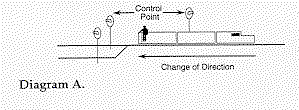
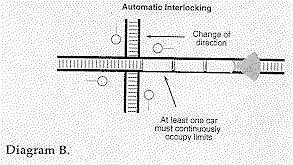
6.5 Handling Cars Ahead of Engine
When cars or engines are shoved and conditions require, a crew member must take an easily seen position on the leading car or engine, or be ahead of the movement, to provide protection. Cars or engines must not be shoved to block other tracks until it is safe to do so.
6.6 Picking Up Crew Member
A train may back up on a main track to pick up a crew
member under the following conditions:
When movement is made under these conditions,
restricted speed does not apply.6.7 Instructions to Clear a Following Train
If the train dispatcher instructs a train within block system limits to clear a following train, the train must be in the clear before the following train could receive a restrictive signal indication.6.8 Stopping Clear for Meeting or Passing
A train that may be met or passed must stop at least 400 feet from the signal or clearance point of the facing point switch the other train will pass over, if length of train permits.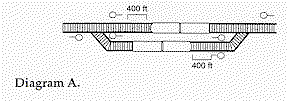
6.9 Meeting or Passing Precautions
A train required to take siding must stop clear of the switch, unless the switch is properly lined to leave the main track.6.10 Calling Attention to Restrictions
The conductor must remind the engineer that the train is approaching an area restricted by:
The conductor must inform the engineer after the train passes the last station, but at least 2 miles from the restriction.6.11 Spacing Trains
In non-signaled territory, a train must not follow another train that has passed or been overtaken until 10 minutes after the train has departed.6.12 FRA Excepted Track
On a track designated as "FRA Excepted Track" the following will govern:
6.13 Yard Limits
Within yard limits, trains or engines are authorized to use the main track not protecting against other trains or engines. Engines must give way as soon as possible to trains as they approach.
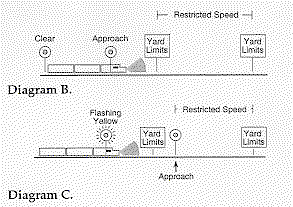
6.14 Restricted Limits
Between designated points specified by signs and in the special instructions, trains and engines may use the main
track not protecting against other trains or engines. All movement must be at restricted speed.
Movements against the current of traffic must not be made unless authorized or protected by track warrant, track bulletin, yardmaster, or other authorized employee.6.15 Block Register Territory
Block register territory will be designated in the special instructions. A register labeled "Block Register Territory" will apply only on that designated territory. A train or operator in charge of men or equipment is authorized to occupy block register territory under the following conditions:

COLUMN REQUIRED ENTRY
A - Enter the train, gang, or equipment identification.
B - Enter last name of conductor or employee in charge of men or equipment.
C - Enter current date.
D - Enter time entry is made in register.
E - Enter time the territory was cleared. Then, draw a line through the entire entry.
The required exit entry may be completed by any authorized employee.
6.16 Approaching Railroad Crossings, Drawbridges, and End of Multiple Main Track
Trains and engines must be prepared to stop when they approach railroad crossings at grade, drawbridges, and the end of multiple main track, unless these areas are protected by block or interlocking signals.
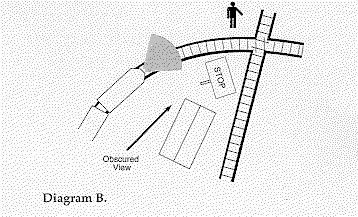
6.17 Switches at Junctions
The normal position for a junction switch is for through movement on the main track where the junction is an intermediate station.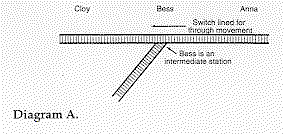
6.18 Stopping Clear of Crossings and Junctions
At a railroad crossing or junction, a train or engine must not stop, if possible, where it could interfere with train movement on the other track.6.19 Flag Protection
A. Flag Protection Not Required
B. More than Half the Maximum Timetable Speed
C. Less than Half the Maximum Timetable Speed

6.19.1 Protection Entering Main Track
In non-signaled territory, unless otherwise relieved of flag protection, a crew member must provide flag protection against a following train before the train moves out of a siding or other track and fouls a main track.6.19.2 Protection of On-Track Equipment
Do not depend on rail detectors and on-track equipment, other than engines or cars, to actuate block signals, interlocking signals, or highway crossing signals or to be under the protection of such signals. Provide flag protection when required.6.19.3 Acknowledgment of Flagging
When flagged, the engineer must acknowledge stop signals promptly. The flagman must continue giving stop signals until the engineer acknowledges them and reacts to them. After stopping, the engineer must be told why the train was flagged and act accordingly.6.19.4 Crossing Over or Fouling Main Track
Except where Rule 6.13 (Yard Limits) or Rule 6.14 (Restricted Limits) is in effect, a train must receive permission from the train dispatcher before crossing over to or obstructing another main track signaled for movement in one direction. Flag protection must be provided against movements against the current of traffic, unless the train dispatcher advises that no movements have been or will be authorized. Crew members who receive this advice must notify the train dispatcher when their movement is clear of the other main track.6.19.5 Protection in ABS by Lining Switch
When a train or engine is within ABS limits and requires flag protection, the protection may be provided by lining and locking a main track switch against movement at or beyond the point where the train or engine will stop movement or clear the main track.6.19.6 Protection of Equipment Left on Main Track
Crews that leave equipment on the main track do not need to provide flag protection for the equipment if the train dispatcher gives verbal relief.6.20 Portion of Train Left on Main Track
When necessary to leave a portion of a train temporarily on the main track, follow this procedure:
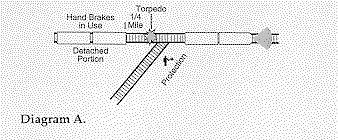
6.21 Precautions Against Unusual Conditions
Protect trains and engines against any known condition that may interfere with their safety.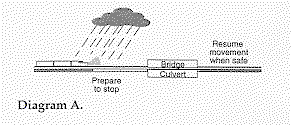
6.21.1 Protection Against Defects
If any defect or condition that might cause an accident is discovered on tracks, bridges, or culverts, or if any crew member believes that the train or engine has passed over a dangerous defect, the crew member must immediately notify the train dispatcher and provide protection if necessary.6.21.2 Water Above Rail
Do not operate trains and engines over tracks submerged in water until the track has been inspected and verified as safe.6.22 Maintaining Control of Train or Engine
Crew members must consider train or engine speed, grade conditions, and air gauge indications to determine that the train or engine is being handled safely and is under control. If necessary, take immediate action to bring the train or engine under control.6.23 Emergency Stop or Severe Slack Action
When a train or engine is stopped by an emergency application of the brakes or severe slack action occurs while stopping, take the following actions:
When only one flagman is available, provide protection immediately in the direction the first train is expected. After necessary protection is provided, provide protection in the opposite direction. Recall the flagman:
Inspection of Cars and Units
Train on Adjacent Track
6.24 Movement on Double Track
On double track, trains must keep to the right unless otherwise instructed.6.25 Movement Against the Current of Traffic
Movements against the current of traffic must be authorized by track bulletin or track warrant, except as provided by:
Trains and engines moving against the current of traffic must approach block signals, interlocking signals, or facing point spring switches prepared to stop unless:
However, this will not apply at a spring switch outside of interlocking limits, if the train dispatcher has advised the crew that the switch is spiked in the normal position.6.26 Use of Multiple Main Tracks
Multiple main tracks will be designated by name or number. When necessary, track use will be indicated in the special instructions.6.27 Movement at Restricted Speed
When a train or engine is required to move at restricted speed, movement must be made at a speed that allows stopping within half the range of vision short of:
The crew must keep a lookout for broken rail and not exceed 20 MPH.6.28 Movement on Other than Main Track
Except when moving on a main track or on a track where a block system is in effect, trains or engines must move at a speed that allows them to stop within half the range of vision short of:
6.28.1 Sidings of Assigned Direction
Do not use sidings of an assigned direction in the opposite direction unless authorized by the train dispatcher.6.28.2 Stopping Clear in Siding
When possible, a train entering a siding must not stop until the entire train is clear of the main track.6.28.3 Cars or Equipment Left on Siding
Avoid leaving cars or equipment on sidings unless authorized by the train dispatcher, except in an emergency. In this case, notify the train dispatcher immediately.6.29 Inspecting Trains
6.29.1 Inspecting Passing Trains
Employees must inspect passing trains. If they detect any of the following conditions, they must notify crew members on the passing train by any available means:
When possible, employees inspecting the passing train must advise crew members of the condition of their train.6.29.2 Train Inspections by Crew Members
When a walking inspection of the train is required, and physical characteristics prevent a complete train inspection, inspect as much of the train as possible. The train may then be moved, but may not exceed 5 MPH for the distance necessary to complete the inspection.
Crew members who discover defects while the train is moving must stop the train promptly and correct any defects, if possible. If the defective car must be set out, they must not attempt to move the car to the setout point unless it is safe to do so.6.30 Receiving or Discharging Passengers
When a passenger train is receiving or discharging traffic, a train, engine, or piece of equipment must not pass between it and the station platform being used unless safeguards are provided.6.31 Maximum Authorized Speed
Conductors and engineers are jointly responsible for knowing and not exceeding the maximum authorized I speed for their train. Passenger speed is applicable only to trains consisting entirely of passenger equipment.
When possible, crew members must notify the train dispatcher promptly of any condition that will delay or prevent their train from making the usual speed.6.32 Road Crossings
6.32.1 Cars Shoved, Kicked, or Dropped
When cars are shoved, kicked, or dropped over road crossings at grade, a crew member must be on the ground at the crossing to warn traffic until the crossing is occupied. Make any movement over the crossing only on the crew member's signal.
6.32.2 Automatic Crossing Devices
Under any of the following conditions, a movement must not foul a crossing equipped with automatic warning devices until the device has been operating long enough to provide warning and the crossing gates, if equipped, are fully lowered:
6.32.3 Protection of Adjacent Tracks
If a train or cut of cars is parted to clear a road crossing or is standing near the crossing, when possible, an employee must be on the ground to warn traffic against trains or engines approaching on adjacent tracks.6.32.4 Clear of Crossings and Signal Circuits
Leave cars, engines, or equipment clear of road crossings and crossing signal circuits.
6.32.5 Actuating Automatic Crossing Signals Unnecessarily
Avoid actuating automatic crossing signals unnecessarily by leaving switches open or permitting equipment to stand within the controlling circuit. If this cannot be avoided and if the signals are equipped for manual operation, a crew member must manually operate the signal for movement of traffic. A crew member must restore signals to automatic operation before a train or engine occupies the crossing or before it leaves the crossing.6.32.6 Blocking Public Crossings
If possible, a standing train or switching movement must avoid blocking a public crossing longer than 10 minutes.
Next Chapter - Switching